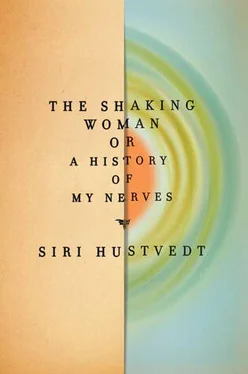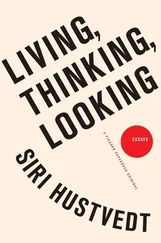Perhaps the most famous example was the behaviorist J.B. Watson, who rejected mental imagery altogether, claiming it did not exist. Watson defended his position in a public debate at the Psychology Club in Washington, D.C., where he declared that “there has never been a discovery in subjective psychology; there has only been medieval speculation.” 151The year before that public dispute took place, Freud published The Ego and the Id (or “The I and the It”), in which he altered his earlier model of the mind. His three earlier categories, conscious, unconscious, and preconscious, first elaborated in The Interpretation of Dreams, were abandoned for a new approach based on how each new division of the mind functioned. Freud’s concept of the ego, or I ( Ich ), was not the internal narrator or waking perceptual consciousness, with its myriad images. It included a developing bodily sense of a self, very similar to a body schema — which determines our feeling of separateness from other people — as well as completely unconscious processes. The id, or it ( das es ), was the wholly unconscious, timeless place of primal urges or drives. The superego, or “over I” ( über-Ich ), was similar to a personal conscience that came about through a person’s first and most important identifications — with his parents. So at the time Freud was remapping his model of the mind with large regions of unconsciousness, Watson was denying that visual imagery, an everyday conscious experience for most people, even existed.
Ideas grow, but they often grow in deep and narrow ditches. Watson was a radical and controversial advocate of behaviorism, but his ideas have had far-reaching effects on science and the philosophy of science. There are people in the world who lack the ability to form images in their minds (my poet-translator and some philosophers perhaps), but they are a minority, and some of them are neurological patients. My question is, If Watson or his like-minded fellow scientists were seeing novels or remembering houses and landscapes or even the words of a text they had read by viewing them again in their minds on page 78, how could they question the existence of mental imagery? Moreover, doesn’t everybody dream? Aren’t dreams visual mental images? Dogmas can make people blind.
REPORT: JUNE 23, 2008. I am traveling with my husband and a friend. We are spending three days in the Pyrenees together and plan to take a walk in the mountains. J. has found one identified as “moderate” in his guide book that evaluates activities for tourists of varying degrees of prowess. We drive to the place where the walk begins, and I climb up the rocky mountain path, bounding from one stone to another. I am proud of my strength (showing off, if it must be told, for the two men behind me), and then I tire. Breathless, I sit down on a boulder and feel my body go into full-blown convulsions, which then subside. This is not emotional, I think to myself. This is not about my father’s death. This is not conversion disorder. I say nothing to my husband or friend, who were too far away to witness my seizure. When I walk back down the mountain, I go slowly. The event has left me weak and unsteady. Later, I look back at a journal entry from that day and read, “I know it wasn’t psychogenic. It was the exertion. It makes me wonder about my whole theory — there is something else going on. Could it be related to my peripheral neuropathy? Can that turn into the shakes?”
When I was in my thirties, I acquired a “body electric,” to borrow Whitman’s phrase. My arms and legs tingled. Shocks of varying degrees leapt up and down my limbs and face. For several months I ignored it. Then I began to fear that I was coming down with some debilitating neurological disease, such as multiple sclerosis. I went to my doctor, who quickly reassured me that MS did not present itself in this way. He called what I had peripheral neuropathy. I suspected that the culprit might be a drug I had been taking as a prophylactic against urinary tract infections. My doctor was doubtful, but when he consulted the Physicians’ Desk Reference, neuropathy was among the possible side effects. The truth is that many drugs are connected to this symptom, which means that it’s possible macrodantin was behind my electric nerves, and it is possible that it wasn’t. I wondered aloud in the doctor’s office if migraineurs might not be more vulnerable to these odd sensations than others, but Dr. K. said no. Later, I discovered that he was wrong. Tinglings and shocks and all manner of peculiar sensations— paresthesias —are common among chronic migraine patients. After undergoing a test for nerve damage, I was told I had the nerves of a sixty-year-old woman, and when I asked the neurologist for a prognosis, he soberly declared, “It could get better; it could get worse; it could stay the same.” I burst out laughing. He did not see the joke. As it turns out, he was right on all counts. It gets better for a while; then it gets worse; and sometimes it stays the same for weeks on end.
MY FANTASY STORY about the shaking woman doubles back on itself as, one by one, living persons replace my imaginary doctors. On G.’s recommendation, I find myself sitting across from Dr. C., a psychiatrist and psychoanalyst, in her office on Park Avenue. Unlike my phantom analyst, Dr. C. is a woman. Like my figment, she has a kind and intelligent face. She listens patiently as I tell her the story of my shaking. When I suggest conversion disorder, she shakes her head gently, a rather sad smile on her face. She does not believe I am hysterical. And when I mention at some point that I had febrile convulsions as an infant, she is all attention. On the day of my christening, my fever rose to 106, and I went into convulsions that terrified my mother. I can’t remember when I first heard my mother tell the story. Why did I mention it to Dr. C.? Because I was telling the fast version of my life story. Why haven’t I written about it here? I missed it. I repressed it. She gives me the telephone number of Dr. L., a neurologist she knows and likes, someone with a reputation for humane treatment of patients, and I agree to make an appointment and have my nerves properly investigated.
DR. L. FAXES ME a ten-page questionnaire about my history. She includes a blank page for further comments. I write two single-spaced pages, documenting my shakes, my migraines, their auras, the tingling in my arms and legs — in short, everything I can think of that seems related to my nervous system. After I finish writing, I remember my room in the neurology ward at Mount Sinai Hospital. I can see the dirty roofs of buildings through the window, the beige tray table, and the small television, which in my memory is black and white, but this dubious detail probably tells more about my emotional state at the time than what I was actually seeing. Nicholas Nickleby is on TV, but the people on the screen are tiny and far away. I can’t focus on them because I seem to be wrapped in layer upon layer of gauze. The thickness of Thorazine. The world has become remote, and I feel I would have to travel a long way to recover its immediacy, its aliveness, its color. I suddenly wonder if when I dragged myself out of bed in the hospital room all those years ago to make my way to the bathroom, I looked like the heavily sedated mental patients I work with every week, the people who shuffle, rather than walk, into the room, their limbs as stiff and wooden as marionettes’. I probably did. Those eight long days. The brusque, indifferent nurses. The interns with their smiles and pin pricks and questions. Is the memory of the hospital the reason why I canceled the epilepsy specialist?
THE DOCTOR IS TALL, forthright, articulate, and friendly. I like her broad, loose movements and feel I am in the presence of a confident person at ease in her body. She seems prepared to take her time. I can tell she has a slightly amused attitude toward my confession, which she has on her desk beside her — much of it gone over with a transparent blue marker. My guess is that she reads with the marker, that the motion of her hand is part of the way she absorbs information. I feel stupidly gratified that my case doesn’t appear to bore her. I am not a cut-and-dried example of anything, it seems. After a short time, it is obvious that just as Dr. C. did, Dr. L. dismisses conversion disorder. She clearly regards it as absurd. She explains that I am too old. If I were fourteen she might entertain the thought, but at fifty-three it’s not possible. I’m not sure this is strictly true as I think over the cases I’ve read about, but then again, my speculative self-diagnosis already took a hit on that climb in the Pyrenees. Also, I’ve begun to feel a tremor running through my limbs, not constantly, but often, as if the grand spasms are an exaggerated version of this buzz saw inside me. She, too, is interested in my febrile convulsions and declares that many people with seizures of one kind or another had them in the first six months of their lives.
Читать дальше












